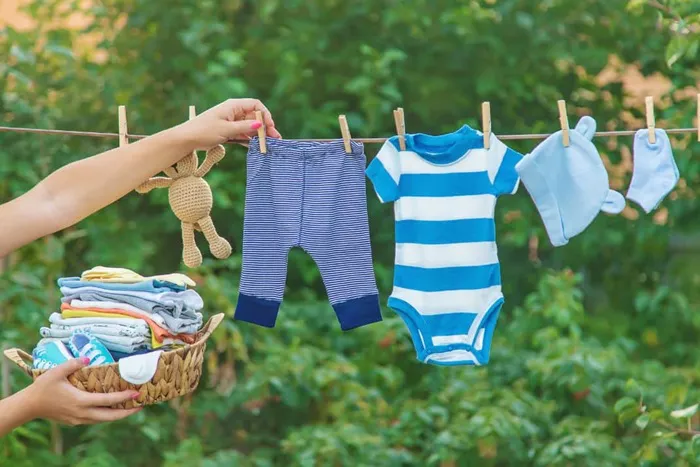Washing baby clothes is an important task for every parent. Babies have sensitive skin and delicate immune systems, so ensuring their clothes are clean and free from irritants is crucial. This guide will provide you with a step-by-step approach to washing baby clothes, offering practical tips and expert advice to keep your baby’s wardrobe fresh, soft, and safe.
Understanding Baby Fabrics
Types of Fabrics
Baby clothes are typically made from various fabrics, including cotton, polyester, bamboo, and blends. Each fabric type requires different care to maintain its softness and durability.
Cotton: Soft, breathable, and absorbent. Ideal for baby clothes but can shrink if washed improperly.
Polyester: Durable, wrinkle-resistant, and retains shape well. Often blended with cotton for added strength.
Bamboo: Hypoallergenic and soft, with natural antibacterial properties. Needs gentle care.
Blends: Combinations of fabrics that offer various benefits, such as durability and comfort.
Reading Labels
Before washing any baby clothes, always read the care labels. These labels provide essential information on how to wash, dry, and iron the garments without causing damage. Look for symbols indicating the appropriate water temperature, type of detergent, and drying method.
Preparing Baby Clothes for Washing
Sorting Clothes
Sort baby clothes by color and fabric type. This helps prevent color bleeding and ensures that delicate fabrics are not damaged by rougher materials. Separate white clothes from colored ones and wash heavily soiled items separately.
Pre-treating Stains
Babies can create stubborn stains from spit-ups, food, and diaper leaks. Pre-treating these stains before washing can make a significant difference.
Spit-up and milk stains: Rinse with cold water and apply a gentle stain remover.
Food stains: Scrape off any solid residue, rinse with cold water, and treat with a stain remover.
Diaper leaks: Rinse the stained area with cold water and apply a stain remover designed for baby clothes.
Fastening Fasteners
Before washing, close all zippers, buttons, and snaps to prevent them from snagging on other clothes. Turn clothes inside out to protect prints and delicate fabrics.
Choosing the Right Detergent
Baby-Safe Detergents
Select a detergent that is free from dyes, fragrances, and harsh chemicals. Look for products labeled as hypoallergenic or formulated for sensitive skin. Avoid using fabric softeners and dryer sheets, as they can contain irritants.
Natural Alternatives
Consider using natural alternatives like baking soda or vinegar. Baking soda can help remove odors and soften clothes, while vinegar can act as a natural fabric softener and disinfectant.
Washing Baby Clothes
Water Temperature
Use the appropriate water temperature as indicated on the care labels. Generally, washing in cold or warm water is best for baby clothes to prevent shrinkage and fading. Hot water can be used for heavily soiled items to kill germs.
Washing Machine Settings
Set your washing machine to a gentle cycle to protect delicate fabrics. Use an extra rinse cycle to ensure all detergent is thoroughly removed, reducing the risk of skin irritation.
Hand Washing
For particularly delicate items, hand washing may be the best option. Fill a basin with lukewarm water and add a small amount of baby-safe detergent. Gently agitate the clothes, then rinse thoroughly with clean water.
See Also: The Guide To Newborn Tutu Dresses
Drying Baby Clothes
Air Drying
Air drying is the gentlest method for drying baby clothes. Hang clothes on a drying rack or clothesline, making sure they are spread out to prevent mildew. Avoid direct sunlight, which can fade colors.
Machine Drying
If you prefer using a dryer, select the lowest heat setting. High heat can damage fabrics and cause shrinkage. Remove clothes from the dryer while they are still slightly damp to avoid over-drying, which can make fabrics rough.
Ironing
Most baby clothes do not require ironing, but if you need to, use the lowest heat setting. Place a thin cloth between the iron and the garment to protect delicate fabrics.
Storing Baby Clothes
Folding and Organizing
Fold baby clothes neatly and store them in a clean, dry place. Use drawer dividers or bins to keep items organized by type and size.
Preventing Odors
Place a small sachet of lavender or baking soda in the drawers to keep clothes smelling fresh. Avoid using mothballs, as they contain chemicals that can be harmful to babies.
Special Care Tips
Washing Cloth Diapers
Cloth diapers require special care to ensure they remain absorbent and free from odors. Rinse diapers in cold water to remove any solids, then wash in hot water with a baby-safe detergent. Avoid using fabric softeners, as they can reduce absorbency.
Handling Hand-Me-Downs
When using hand-me-downs, wash them thoroughly before dressing your baby. Inspect the clothes for any wear and tear, and repair or discard items that are damaged.
Common Mistakes to Avoid
Using Too Much Detergent
Using too much detergent can leave residue on clothes, which can irritate your baby’s skin. Follow the manufacturer’s instructions and use the recommended amount.
Overloading the Washing Machine
Overloading the washing machine can prevent clothes from being cleaned properly and cause excessive wear. Wash smaller loads to ensure thorough cleaning and rinsing.
Ignoring Stain Removal
Leaving stains untreated can make them harder to remove later. Always pre-treat stains promptly to keep baby clothes looking their best.
Conclusion
Washing baby clothes may seem like a simple task, but it requires attention to detail and the right techniques to ensure your baby’s comfort and safety. By understanding fabric types, using the right detergents, and following proper washing and drying methods, you can keep your baby’s clothes soft, clean, and free from irritants. Remember, a little extra care goes a long way in maintaining the quality and longevity of your baby’s wardrobe.
Related topics:
- How To Dress A Newborn In The Hospital
- 6 Best Infant Life Jackets Of 2024
- Where To Buy Little Me Brand

